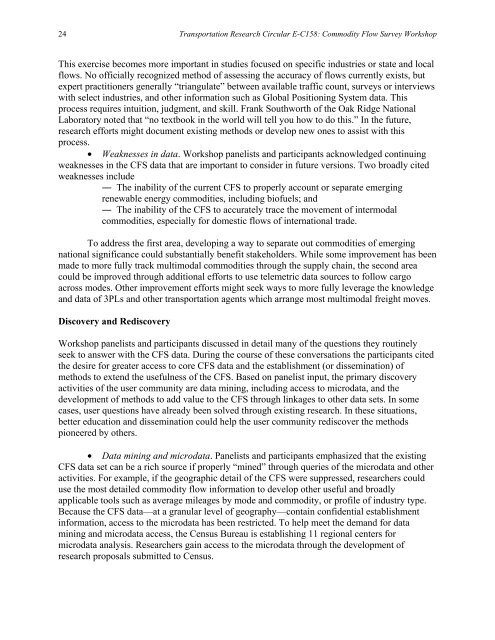E-C158 Cover1 - Center for Transportation Analysis - Oak Ridge ...
E-C158 Cover1 - Center for Transportation Analysis - Oak Ridge ...
E-C158 Cover1 - Center for Transportation Analysis - Oak Ridge ...
Create successful ePaper yourself
Turn your PDF publications into a flip-book with our unique Google optimized e-Paper software.
24 <strong>Transportation</strong> Research Circular E-<strong>C158</strong>: Commodity Flow Survey Workshop<br />
This exercise becomes more important in studies focused on specific industries or state and local<br />
flows. No officially recognized method of assessing the accuracy of flows currently exists, but<br />
expert practitioners generally “triangulate” between available traffic count, surveys or interviews<br />
with select industries, and other in<strong>for</strong>mation such as Global Positioning System data. This<br />
process requires intuition, judgment, and skill. Frank Southworth of the <strong>Oak</strong> <strong>Ridge</strong> National<br />
Laboratory noted that “no textbook in the world will tell you how to do this.” In the future,<br />
research ef<strong>for</strong>ts might document existing methods or develop new ones to assist with this<br />
process.<br />
• Weaknesses in data. Workshop panelists and participants acknowledged continuing<br />
weaknesses in the CFS data that are important to consider in future versions. Two broadly cited<br />
weaknesses include<br />
― The inability of the current CFS to properly account or separate emerging<br />
renewable energy commodities, including biofuels; and<br />
― The inability of the CFS to accurately trace the movement of intermodal<br />
commodities, especially <strong>for</strong> domestic flows of international trade.<br />
To address the first area, developing a way to separate out commodities of emerging<br />
national significance could substantially benefit stakeholders. While some improvement has been<br />
made to more fully track multimodal commodities through the supply chain, the second area<br />
could be improved through additional ef<strong>for</strong>ts to use telemetric data sources to follow cargo<br />
across modes. Other improvement ef<strong>for</strong>ts might seek ways to more fully leverage the knowledge<br />
and data of 3PLs and other transportation agents which arrange most multimodal freight moves.<br />
Discovery and Rediscovery<br />
Workshop panelists and participants discussed in detail many of the questions they routinely<br />
seek to answer with the CFS data. During the course of these conversations the participants cited<br />
the desire <strong>for</strong> greater access to core CFS data and the establishment (or dissemination) of<br />
methods to extend the usefulness of the CFS. Based on panelist input, the primary discovery<br />
activities of the user community are data mining, including access to microdata, and the<br />
development of methods to add value to the CFS through linkages to other data sets. In some<br />
cases, user questions have already been solved through existing research. In these situations,<br />
better education and dissemination could help the user community rediscover the methods<br />
pioneered by others.<br />
• Data mining and microdata. Panelists and participants emphasized that the existing<br />
CFS data set can be a rich source if properly “mined” through queries of the microdata and other<br />
activities. For example, if the geographic detail of the CFS were suppressed, researchers could<br />
use the most detailed commodity flow in<strong>for</strong>mation to develop other useful and broadly<br />
applicable tools such as average mileages by mode and commodity, or profile of industry type.<br />
Because the CFS data—at a granular level of geography—contain confidential establishment<br />
in<strong>for</strong>mation, access to the microdata has been restricted. To help meet the demand <strong>for</strong> data<br />
mining and microdata access, the Census Bureau is establishing 11 regional centers <strong>for</strong><br />
microdata analysis. Researchers gain access to the microdata through the development of<br />
research proposals submitted to Census.

















